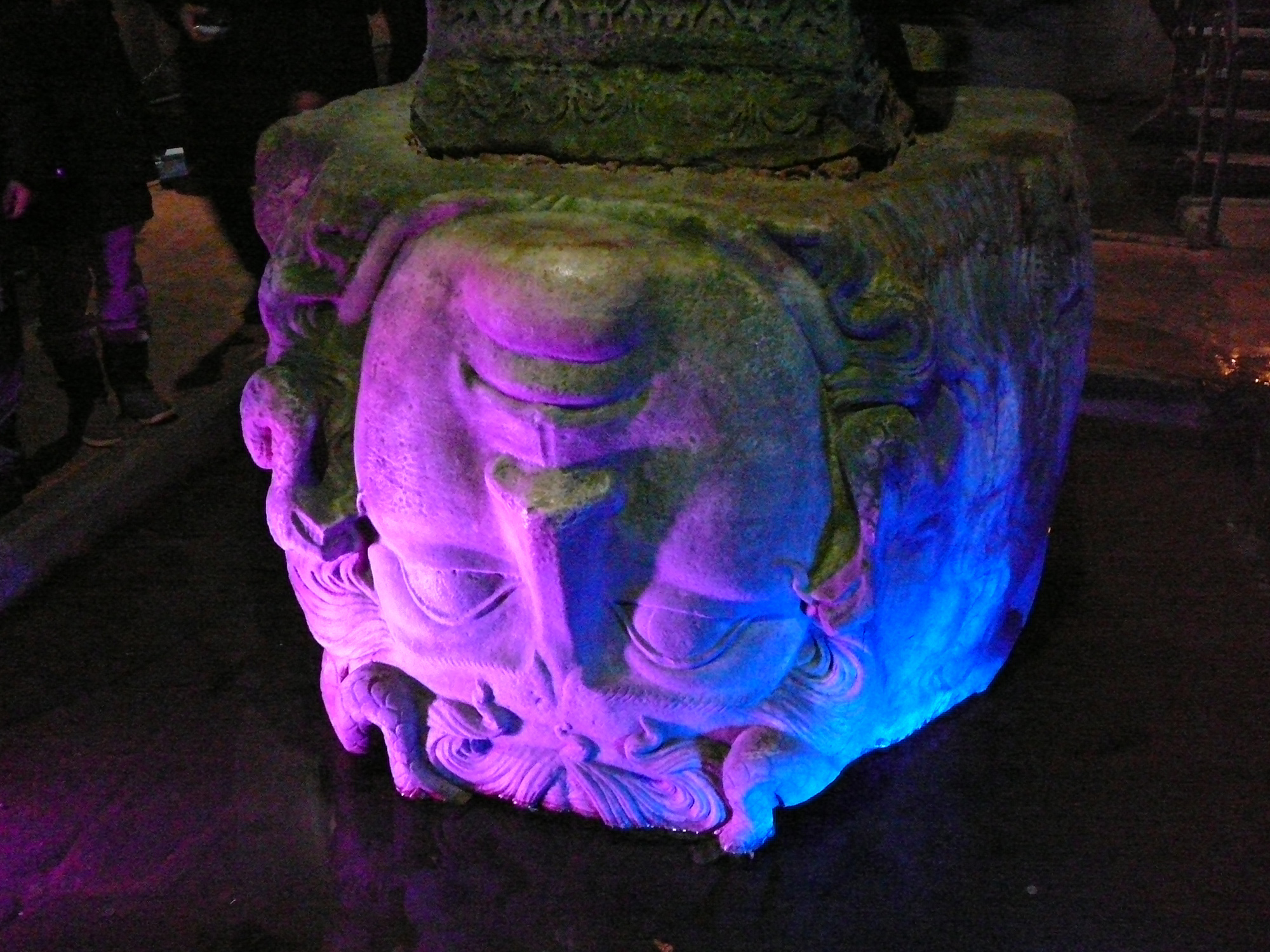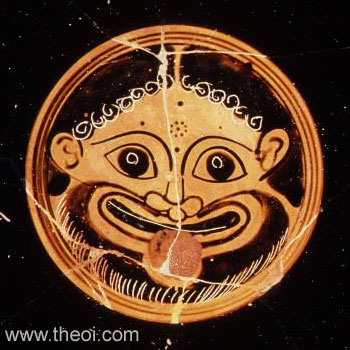 |
| Gorgon Head in the Cistern Basilica or Yerebatan Saray, Istanbul |
Gorgoneion, may have served a function similar to that of the stylised
eyes in Modern Mediterranean fetish beads.” (Phinney. 1971. Perseus's battle with the Gorgons. Transactions and
Proceedings of the American Philological Association. Vol. 102 p.447)
The Cistern Basilica in Istanbul was an underground water reservoir
built by the Byzantines in the 6th century. One aspect that has
puzzled academics to this day is the reasons behind the existence of Gorgon heads within (see picture above). It would not be possible to
conclude this argument in a blog but I will aim to support the theory that they were an apotropaic object.
Many academics have maintained that Gorgoneions were popular
in antiquity. What was a Gorgoneion? Furtwangler writing in the late 19th
century believed that the Medusa Rondanini in particular was a religious dedication.
(cited in Belson. 1980. The Medusa Rondanini: A New Look. American Journal of Archaeology. Vol. 84. No. 3 p.374) This can be seen by the Gorgons that were hung up in religious building or
dedicated to people such as Antiochus IV in Athens. Others have pointed out
that Gorgoneions also appear on shields, vases and above doors and have suggested
an alternative function of it as apotropaic. Athena is able to use Medusa’s head
on her aegis both for good and bad, accordingly people also seemed to have used the image of medusa and her power to petrify for thier own needs. This is supported by the existence of
an amulet with Perseus and the severed head of Medusa on one side, with an inscription on the other saying “Flee, gout, Perseus is chasing you!” (Kotansky. 1991. Incantations and Prayers for Salvation on Inscribed Greek Amulets. Magika Hiera p.119) Wilk stated “the Gorgoneion shows up in many circumstances where it is clearly supposed to be a warning.” (2000 p.42) The warning was intended for either the evil eye or evil influences. How exactly the Gorgoneion worked, has been debated among academics. As seen in the amulet above even disease adopted a anthropomorhic nature able to fear and flee. One popular theory in how it scared away evil was through its fearsome features. Many such as Root (2007) have supported this idea, and can be seen by the fanged grinning mouth, large eyes, lolling tongue and sometimes the appearance of a beard as can be seen by the images below.


British Museum, London, United Kingdom
Attic Red Figure
460 BC
It has been argued that the Gorgoneion was used as a form of protection against mortal enemies as well. This is evident with the existence of gorgons on shields, where it has been argued that the image served as a distraction for the enemy on the battlefield. (Wilk p.156) This is further supported in a play by Aristophanes in which one character cannot bear the image of the gorgon on a shield until it is placed upside down on the ground. (Aristophanes. Arharnians p.572) The connection of the the depictions above and shields seems to be further supported by the fact Baschor was criticised for believing the Medusa Rondanini was supposed to be on Athena's aegis as all those Gorgons contrasted with Athena's beauty. (cited in Belson. 1980 p.375)
However an alternative theory of how the gorgoneion worked could answer how the image of the Gorgon could change yet remain an apotropiac object. That it served essentailly as a distraction for evil spirits. (Hildburgh. 1946. Apotropaism in Greek Vase-Paintings. Folklore, Vol. 57 No.4 p.155) Particularly her eyes. This could be supported by the fact that several Ancient Greek and Etruscan vases had eyes on them instead of Gorgons. The Gorgon in Istanbul still possesses large eyes. The connection with the power attached to the eyes also has a psychological level. In several experiments tracking eye movement in the 1960s Yarbus found when subjects looked at a photograph, they unconsciously kept returning to the eyes. (cited in Wilk p.152) It could be suggested that the Ancient Greeks knew this and used the unavoidable gaze of the Gorgon for this use.
But one last mystery
remains. The Cistern Basilica was constructed after several centuries of Christianity.
There has been one suggested that the gorgons were simply there as they
were the right size for column supports. However one is sideways and another is
placed upside down. If the Gorgons were turned at the site it could suggest that
the builders were aware of the power attached to them, and possibly anxious to counter
it. However this can never be known.
In Conclusion the gorgon heads were constructed in an earlier period and were likely to be used as a form of apotropaic object. Although there is no agreement it seems that the most likely way the Gorgoneion protected against evil was to distract it, particularly with its eyes. Such beliefs could have survived into the 6th century in one form or another.
Bibliography
1. Aristophanes. Acharnians. http://www.perseus.tufts.edu/hopper/text?doc=Perseus%3Atext%3A1999.01.0240%3Acard%3D572
2. Belson, J. D. Jul 1980. The Medusa Rondanini. American Journal of Archaeology. Vol.84 No.3. pp.373-378
3. Hildburgh, W.L. Dec 1946. Apotropaism in Greek Vase Paintings. Folklore Vol. 57 No. 4 pp.154-178
4. Kotansky, R. 1991. Incantations and and Prayers for Salvationon inscribed Greek Amulets. Magika Hiera: Ancient Greek Magic and Religion. Ed. Haraone and Obbink. pp.107-137
5. Phinney. E. Jr. 1971. Perseus's Battle with the Gorgons. Transactions and proceedings of the American Philological Association. Vol. 102 pp.445-4663
6. Root. I.B. 2007. Redeeming the Gorgon: Reclaiming the Medusa Function of Psyche.
7. Wilk. S. 2000. Medusa: Solving the mystery of the Gorgon.
In Conclusion the gorgon heads were constructed in an earlier period and were likely to be used as a form of apotropaic object. Although there is no agreement it seems that the most likely way the Gorgoneion protected against evil was to distract it, particularly with its eyes. Such beliefs could have survived into the 6th century in one form or another.
Bibliography
1. Aristophanes. Acharnians. http://www.perseus.tufts.edu/hopper/text?doc=Perseus%3Atext%3A1999.01.0240%3Acard%3D572
2. Belson, J. D. Jul 1980. The Medusa Rondanini. American Journal of Archaeology. Vol.84 No.3. pp.373-378
3. Hildburgh, W.L. Dec 1946. Apotropaism in Greek Vase Paintings. Folklore Vol. 57 No. 4 pp.154-178
4. Kotansky, R. 1991. Incantations and and Prayers for Salvationon inscribed Greek Amulets. Magika Hiera: Ancient Greek Magic and Religion. Ed. Haraone and Obbink. pp.107-137
5. Phinney. E. Jr. 1971. Perseus's Battle with the Gorgons. Transactions and proceedings of the American Philological Association. Vol. 102 pp.445-4663
6. Root. I.B. 2007. Redeeming the Gorgon: Reclaiming the Medusa Function of Psyche.
7. Wilk. S. 2000. Medusa: Solving the mystery of the Gorgon.
The eyes in the ancient Greek culture is a very interesting topic. The importance of it can also be seen in what they understood by knowing and thruth (oida and aletheia). I think we could say that it was a culture based upon sight.
ReplyDelete